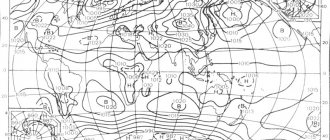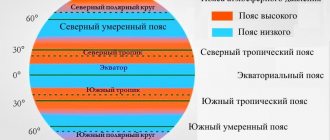Hello, dear readers of the KtoNaNovenkogo.ru blog. In the weather forecast, among the well-known indicators (temperature, precipitation, humidity, wind speed, etc.), atmospheric pressure is also present.
It is expressed not in our usual units of measurement (atmosphere, bar, pascal), but in millimeters of mercury.
We will tell you below where this pressure comes from, how it is measured, what kind of “mercury column” is and how it affects human health.
What is atmospheric pressure?
Atmospheric pressure is the pressure of the gaseous shell of our planet, the atmosphere, which acts on all objects in it, as well as the earth's surface. Pressure corresponds to the force that acts in the atmosphere per unit area.
Earth's atmosphere (photo from the ISS)
In simpler terms, this is the force with which the air around us acts on the surface of the earth and objects. By monitoring changes in atmospheric pressure, it is possible, in conjunction with other factors, to predict weather conditions.
Test to consolidate learned material
Test on the topic: “Atmospheric pressure”
Sources:
- Tomilin A. N., Terebinskaya N. V. Why nothing? Essays. /L., “Det. lit.”, 1975.
- Ya. I. Perelman. Entertaining tasks and experiments. - M.: “Children's Literature”, 1972.
- Physical Geography: Reference. aid for preparation. dept. universities/G. V. Volodina, I. V. Dushina, S. G. Lyubushkina and others; Ed. K.V. Pashkanga - M.: Higher. school, 1991.
- Tarasov L.V. Atmosphere of our planet. - M.: FIZMATLIT, 2012.
- Savtsov T.M. General geography: Textbook. aid for students higher ped. textbook institutions - M.: Publishing House, 2003
- Dronov V.P. Geography. 5-6 grades: Textbook/V. P. Dronov, L. E. Savelyeva. 5th ed., stereotype. - M.: Bustard, 2015.
- Geography grades 5-6: textbook. for general education institutions / A. I. Alekseev, E. K. Lipkina, V. V. Nikolina, etc.; Edited by A. I. Alekseev. - M.: Education, 2012.
Why and due to what is atmospheric pressure created?
Specialists who study the Earth's atmosphere and various meteorological phenomena carefully monitor how air masses move. This is the main factor influencing the climatic conditions of a particular area. These observations made it possible to understand why atmospheric pressure arises.
It's all because of gravity.
Through many experiments it has been proven that air is by no means weightless. It consists of various gases that have a certain weight. Thus, the force of gravity of the Earth acts on the air, which contributes to the formation of pressure. Interesting fact : all the air on the planet (or the entire atmosphere of the Earth) weighs 51 x 1014 tons.
The air mass around the globe is not the same. The level of atmospheric pressure fluctuates accordingly. Areas with more air mass experience higher pressure. If there is less air (it is also called rarefied in such cases), then the pressure is lower.
Movement Sun
Why does the weight of the atmosphere change? The secret of this phenomenon lies in the heating of air masses. The fact is that the heating of the air does not occur at all from the sun's rays, but due to the earth's surface.
Near it, the air heats up and, becoming lighter, rises. At this time, the cooled flows become heavier and fall down. This process occurs continuously. Each air flow has its own pressure, and its difference causes wind.
Introduction
It's raining outside the window today.
After the rain, the air temperature decreased, humidity increased and atmospheric pressure decreased. Atmospheric pressure is one of the main factors determining the state of weather and climate, so knowledge of atmospheric pressure is necessary in weather forecasting. The ability to measure atmospheric pressure is of great practical importance. And it can be measured with special barometer devices. In liquid barometers, as the weather changes, the liquid column decreases or increases. Knowledge about atmospheric pressure is necessary in medicine, in technological processes, in human life and in all living organisms. There is a direct connection between changes in atmospheric pressure and changes in weather. An increase or decrease in atmospheric pressure can be a sign of weather changes and affect a person’s well-being.
Description of three interrelated physical phenomena from everyday life:
- Relationship between weather and atmospheric pressure.
- Phenomena underlying the operation of instruments for measuring atmospheric pressure.
- Dependence of liquid pressure on the height of the liquid column in liquid barometers.
Relevance of the work
The relevance of the chosen topic is that at all times people, thanks to their observations of animal behavior, could predict weather changes, natural disasters, and avoid human casualties.
The influence of atmospheric pressure on our body is inevitable; sudden changes in atmospheric pressure affect a person’s well-being, and weather-dependent people especially suffer. Of course, we cannot reduce the influence of atmospheric pressure on human health, but we can help our own body. The ability to measure atmospheric pressure, knowledge of folk signs, and the use of homemade instruments can help to properly organize your day, distribute time between work and rest.
Purpose of the work: to find out what role atmospheric pressure plays in human daily life.
Tasks:
- Study the history of atmospheric pressure measurement.
- Determine whether there is a connection between weather and atmospheric pressure.
- Study the types of instruments designed to measure atmospheric pressure, made by man.
- Study the physical phenomena underlying the operation of instruments for measuring atmospheric pressure.
- Dependence of liquid pressure on the height of the liquid column in liquid barometers.
Research methods
- Literature analysis.
- Summarizing the information received.
- Observations.
Field of study: atmospheric pressure
Hypothesis : atmospheric pressure is important for humans.
Significance of the work : the material of this work can be used in lessons and in extracurricular activities, in the lives of my classmates, students of our school, and all lovers of nature research.
Work plan
I. Theoretical part (information collection):
- Review and analysis of literature.
- Internet resources.
II. Practical part:
- observations;
- collecting weather information.
III. Final part:
- Conclusions.
- Presentation of work.
How does the composition of the atmosphere affect pressure?
The atmosphere contains a huge amount of gases. These are mainly nitrogen and oxygen (98%). There is also carbon dioxide, neon, argon, etc. The atmosphere begins with a boundary layer 1-2 km thick and ends with the exosphere at an altitude of about 10,000 km, where it smoothly passes into interplanetary space.
Atmospheric composition
The composition of the atmosphere affects pressure due to density. Each component has its own density. The higher the altitude, the thinner the layer of the atmosphere and the lower its density. The pressure decreases accordingly.
Atmospheric pressure measurement
In the International System of Units, atmospheric pressure is measured in pascals (Pa). Also in Russia, units such as bar, millimeters of mercury and their derivatives are used. Their use is due to instruments that measure pressure - mercury barometers. 1 mmHg corresponds to about 133 Pa.
There are two types of barometers:
- liquid;
- mechanical (aneroid barometer).
Liquid barometers are filled with mercury. The invention of this device is the merit of the Italian scientist Evangelista Torricelli. In 1644, he conducted an experiment with a container, mercury and a flask, which was lowered into the liquid with an open hole.
Interesting: Tsunami: what is it, causes, types, consequences, photos and videos
As the pressure changed, the mercury rose and fell in the flask. Modern mercury barometers with scales are considered the most accurate, but not very convenient, so they are used at meteorological stations.
Barometers
Aneroid barometers are more common . The design of such a device includes a metal box with rarefied air inside. When the pressure decreases, the box expands. With increasing pressure, the box compresses and acts on the attached spring. The spring moves a pointer that displays the pressure level on a scale.
Interesting fact : there is a standard unit of pressure (as well as other units of physical quantities). The primary standard, which displays absolute pressure as accurately as possible, is located at the All-Russian Mendeleev Research Institute of Metrology (St. Petersburg).
Measuring instruments
In geography, there are 2 devices with which you can determine atmospheric pressure:
- Mercury barometer. Mainly used at weather stations, since the device is fragile and mercury is an extremely dangerous metal.
- Aneroid barometer.
A mercury barometer is a glass tube 1 meter in size. One end of this pipe is tightly sealed, and the other is lowered into a bowl that contains mercury. When the device is first turned over, liquid fills the pipe and indicates the current pressure. It would seem that mercury should completely fill the pipe, but this does not happen. The reason is precisely the air pressure. Subsequently, under the influence of this indicator, the mercury rises or falls in the flask, allowing meteorologists to talk about the current pressure in and is translated as “without liquid.” As a result, the device becomes more “dynamic” and can be safely transported to any distance. It is based on a round box from which all the air has been pumped out and which is absolutely sealed. It changes its size depending on atmospheric pressure: it expands when it increases and contracts when it decreases.
Normal atmospheric pressure for humans
Normal atmospheric pressure is 760 mmHg or 101,325 Pa at 0℃ at sea level (45º latitude). At the same time, the atmosphere acts on every square centimeter of the earth's surface with a force of 1.033 kg. A column of mercury 760 mm high balances the mass of this air column.
The figure of 760 mm was also determined by Torricelli during the experiment. He also noticed that when a flask is filled with mercury, there is a void at the top. Subsequently, this phenomenon was called the “Torricelli void.” Then the scientist did not yet know that during his experiment he created a vacuum - that is, a space free from any substances.
At a standard pressure of 760 mmHg a person feels most comfortable. If we take into account the previous data, then the air presses on a person with a force of about 16 tons. Why then do we not feel this pressure?
The fact is that there is also pressure inside the body. Not only people, but also representatives of the animal world have adapted to atmospheric pressure. Each organ was formed and developed under the influence of this force. When the atmosphere acts on a body, this force is distributed evenly over the entire surface. Thus, the pressure is balanced and we do not feel it.
Atmospheric pressure map of Russia
The atmospheric pressure norm should not be confused with the climate norm. Each region has its own standards for a certain time of year. For example, residents of Vladivostok are lucky, since the average annual atmospheric pressure there is almost equal to the norm - 761 mm Hg.
And in settlements located in mountainous areas (for example, in Tibet), the pressure is much lower - 413 mm Hg. This is due to the altitude of about 5000 m.
Meteor dependence what to do?
The movement of mercury by more than one division in 3 hours is a reason for stress in the strong body of a healthy person. Each of us feels such fluctuations in the form of headaches, drowsiness, and fatigue. More than a third of people suffer from weather dependence to varying degrees of severity. In the zone of high sensitivity are populations with diseases of the cardiovascular, nervous and respiratory systems, and elderly people. How to help yourself if a dangerous cyclone is approaching?
Read also: Feeling of dry throat
15 ways to survive a weather cyclone
There's not a lot of new advice here. It is believed that together they alleviate suffering and teach the correct way of life in case of weather vulnerability:
- See your doctor regularly. Consult, discuss, ask for advice in case your health worsens. Always have prescribed medications on hand.
- Buy a barometer. It is more productive to track the weather by the movement of the mercury column, rather than by knee pain. This way you will be able to anticipate the approaching cyclone.
- Keep an eye on the weather forecast. Forewarned is forearmed.
- On the eve of a weather change, get enough sleep and go to bed earlier than usual.
- Adjust your sleep schedule. Provide yourself with a full 8 hours of sleep, getting up and falling asleep at the same time. This has a powerful restorative effect.
- Meal schedule is equally important. Maintain a balanced diet. Potassium, magnesium and calcium are essential minerals. Ban on overeating.
- Take vitamins in a course in spring and autumn.
- Fresh air, walks outside - light and regular exercise strengthens the heart.
- Don't overexert yourself. Putting off household chores is not as dangerous as weakening the body before a cyclone.
- Accumulate favorable emotions. A depressed emotional background fuels the disease, so smile more often.
- Clothes made from synthetic threads and fur are harmful due to static current.
- Keep folk remedies for relieving symptoms in a list in a visible place. It’s hard to remember a recipe for herbal tea or a compress when your temples are aching.
- Office workers in high-rise buildings suffer more often from weather changes. Take time off if possible, or better yet, change jobs.
- A long cyclone means discomfort for several days. Is it possible to go to a quiet region? Forward.
- Prevention at least a day before the cyclone prepares and strengthens the body. Do not give up!
Don't forget to take vitamins to improve your health
Atmospheric pressure is a phenomenon that is absolutely independent of humans. Moreover, our body obeys it. What the optimal pressure should be for a person is determined by the region of residence. People with chronic diseases are especially susceptible to weather dependence.
Increase and decrease in pressure
When the pressure exceeds 760 mm. Hg Art., it is called elevated, and when the indicator is less than normal - reduced.
Several changes in atmospheric pressure occur within 24 hours. In the morning and evening it increases, and after 12 noon and night it decreases. This happens due to the fact that the air temperature changes and, accordingly, its flows move.
During the winter period, the highest atmospheric pressure is observed over the mainland of the Earth, because the air has a low temperature and is highly dense. In summer, the opposite situation is observed - minimal pressure is observed.
On a more global scale, pressure levels also depend on temperature. The Earth's surface heats up unevenly: the planet has a geoid (rather than perfectly round) shape and revolves around the Sun. Some zones heat up more, others less. Because of this, atmospheric pressure is distributed zonally over the surface of the planet.
Atmospheric pressure belts
Scientists identify 3 belts where low pressure predominates and 4 belts with predominant highs. The equator area warms up the most, so light warm air rises, and low pressure forms at the surface.
Interesting: Climatic zones of the world - classification, map, description of climate types, photos and videos
Near the poles, the opposite is true: cold air sinks, so there is high pressure. If you look at the diagram of pressure distribution over the surface of the planet, you will notice that the belts of minimums and maximums alternate.
In addition, you need to remember about the uneven heating of both hemispheres of the Earth throughout the year. This leads to a certain displacement of the low and high pressure belts. In summer they move northwards, and in winter – southwards.
From the history of the discovery of knowledge about weight, air pressure and the invention of the barometer
E. Torricelli , figured out how to measure atmospheric pressure . Together with V. Viviani , a young student of Galileo, he conducted experiments to measure it. Torricelli was also one of Galileo's last students, and based on his guesses, he proved that air has weight and exerts pressure.
Evangelista Torricelli and his barometer. Author: Saperaud~commonswiki
Torricelli was the first to openly oppose Aristotle's dogmas. Speaking about the pump, he stated that
“First of all, the water rises after the piston not at all because “nature is afraid of emptiness,” it’s just that the water is driven into the pump by the pressure that the air exerts on the surface of the river. There is no air in the pump pipe, under the piston, so water enters it until the weight of the water column in the pump pipe balances the external air pressure.”
But he proved it a little later. The experiment he proposed was carried out in 1643. In this experiment, a glass tube about 1 m long was used, sealed at one end. It was filled with mercury and, having closed it with a finger (so that the mercury did not spill out ahead of time), turned it over, and lowered it into a wide cup with mercury.
Some of the mercury poured out of the tube, and a vacuum formed in its upper part (the first real void discovered on Earth - the Torricelli void ). In this case, the height of the mercury column in the tube turned out to be approximately 760 mm (if measured from the level of mercury in the cup). The air pressed on the mercury of the cup and did not allow it to flow out of the tube.
The scientist also guessed that atmospheric pressure is associated with weather changes. Observing the height of the mercury column in the tube, Torricelli noticed that atmospheric pressure was not constant and depended on “warmth or cold.” The column in the tube lowered and then rose, indicating the desired division of the scale. That is why millimeter of mercury (mmHg) is taken as one of the units of pressure. Gravity in Greek is "baros", and Torricelli's device began to be called a barometer .
Operating principle of the Torricelli barometer
Almost simultaneously with Torricelli, another famous scientist of that time, Descartes, . He explained why perfume does not flow out of a bottle with a hole in the bottom when the lid is closed, but does flow out when it is open, precisely because of the difference in air pressure on different surface areas. When the bottle cap is closed, the surface tension of the water at the small opening is able to hold the liquid in the bottle. When the lid is open, it is overcome by the force of air pressure and the perfume begins to flow out. Descartes hypothesized that with height the air becomes thinner, which means its pressure should also decrease.
After Torricelli’s experiments, Descartes instructed the talented French mathematician and physicist Blaise Pascal to test his guess - whether it was true that pressure decreases with height. To do this, he had to climb the mountains with Torricelli's pipe. The descending column of mercury at the height of Mount Puy de Dome confirmed the hypotheses of Torricelli and Descartes.
Pascal concluded:
“the laws of fluid pressure, known since the time of the glorious Archimedes and developed by the Dutchman Simeon Stevin , are in many ways valid for air.”
Air pressure is not noticed by a person, because according to the laws of pressure in liquids and gases, it is directed both to the sides and down.
Impact on humans
Atmospheric pressure has a serious impact on the human body. This is quite natural, if we take into account all of the above regarding the force with which the air presses on our body and the resistance provided.
How changes in weather affect people
There is a concept of meteorological dependence, confirmed by science and medicine. Meteopaths are people whose body reacts to even minimal pressure deviations from the norm. These also include people with certain chronic diseases (in particular cardiovascular, nervous system, etc.).
In general, the human body can adapt to changing climatic conditions. For example, when traveling to a country with completely different weather conditions, it may take several days to acclimatize.
Significant deviations from the norm will be noticeable for absolutely any person. This includes both high and low blood pressure.
In ordinary life, an increase in atmospheric pressure to a critical level, at which a person’s well-being deteriorates, does not occur (with the exception of the above-mentioned weather-dependent and chronically ill people). You can feel its effect, for example, when diving to great depths.
Low and high blood pressure
Low atmospheric pressure is more dangerous. Its effects can be easily felt at high altitudes. There is a concept of altitude sickness, in which the amount of carbon dioxide increases. In this case, the volume of oxygen, on the contrary, decreases, so the body tissues feel oxygen starvation. The vessels quickly react to this, provoking a sharp increase in pressure in the body.
Isobaths
Isobats are used in cartography, denoting lines that connect marks that characterize equal atmospheric pressure. The definition may seem complicated, but the examples below will make everything clear. There are 2 types of such points: closed and open.
An example of a closed isobar is a cyclone. Inside such an isobath, there is low atmospheric pressure, since a large amount of precipitation falls, which forms evaporation, and also interferes with the rapid heating of the surface. As a result, an area of low pressure is formed inside, and it is surrounded by an area of high pressure.
An example of an open isobar is an anticyclone. In this case, in the center there is an area with high atmospheric pressure, and outside it there is an area with low atmospheric pressure. These situations arise when there is no precipitation inside the isobath for a long time, and the surface warms up easily and quickly. This is one of the sources of high atmospheric pressure. Such isobaths are most often found in the South Pacific or North Atlantic Ocean.
Cyclone
A cyclone is a huge mass of air that rotates in the form of a vortex around a vertical axis with a diameter of up to several thousand kilometers. At the center of this vortex there is low pressure.
Cyclones
In the Northern Hemisphere, the atmospheric vortex of a cyclone rotates counterclockwise, in the Southern Hemisphere it rotates clockwise. Cyclones occur regularly, since their formation is directly related to the rotation of the Earth. There are no cyclones near the equator.
There are two types of cyclones:
- Tropical. They occur in tropical latitudes and are relatively small in size. However, they are characterized by enormous, destructive wind power.
- Extratropical. Formed in polar and temperate latitudes. They reach several thousand kilometers in diameter.
Interesting fact : in tropical cyclones, the “eye of the storm” is often observed - this is an area of about 20 km in size in the very center of the vortex, in which clear and calm weather remains.
The main distinguishing features of a cyclone are colossal energy, which manifests itself in the form of strong winds, storms, thunderstorms, squalls, and precipitation. Powerful tropical cyclones are given unique names or names, for example, Katrina (2005), Nina (1975), Dorian (2019).
Anticyclone
An anticyclone is not only the opposite of a cyclone. This phenomenon has a different mechanism of occurrence. The wind in both hemispheres of the Earth moves in the opposite direction compared to the cyclone.
Anticyclone
An anticyclone is an area of high pressure. It is characterized by closed isobars - these are lines that mark places with the same atmospheric pressure.
An anticyclone brings stable weather conditions corresponding to the time of year. In summer it is windless, hot weather, in winter it is frosty. Characterized by few or no clouds.
Interesting: How is wind speed measured?
Anticyclones form in certain areas. For example, most often they occur over large bodies of ice: in Antarctica, Greenland, and the Arctic. Also found in the tropics.
Anticyclones also carry danger and unpleasant consequences. They can contribute to fires and prolonged droughts. When there is no wind for a long time in large cities, harmful substances and gases accumulate, which is especially acute for people with respiratory diseases.
Difference between cyclone and anticyclone
Interesting fact : there are blocking cyclones that form over a certain area and do not move anywhere. At the same time, they do not allow other air masses to pass through. Usually they last no longer than 5 days, but regularly in the European part of Russia anticyclones last for about a month. The last time this happened was in 2015. The result is heat, drought, forest fires.
Cyclones and anticyclones
There are two main types of pressure systems in the atmosphere: cyclones and anticyclones. Cyclones and anticyclones are wind systems that have opposite characteristics.
A cyclone is a collection of winds circulating in a low pressure system. It rotates counterclockwise in the Northern Hemisphere and clockwise in the Southern Hemisphere. It is usually associated with wet and stormy weather.
An anticyclone is a type of wind that circulates in a high pressure system. It rotates clockwise in the Northern Hemisphere and counterclockwise in the Southern Hemisphere. It is usually associated with dry and clear weather.
In order to better understand how these two phenomena differ, let's look at them in more detail.
A cyclone is an area of low pressure where air masses rise. This usually indicates bad weather, such as rain or clouds. Winds in cyclones blow counterclockwise in the northern hemisphere and clockwise in the southern hemisphere. In a cyclone, air near the ground is forced toward the low-pressure center of the cyclone and then rises, expanding and cooling as it moves. As the rising air cools, it becomes more humid, leading to cloudiness and high humidity inside the cyclone. The main effects of tropical cyclones include heavy rain, strong winds, severe storm surges close to shore, and tornadoes. Destruction from a tropical cyclone, such as a hurricane or tropical storm, mainly depends on its intensity, size and location.
There are two types of cyclones:
1. Tropical cyclones . These cyclones that form over warm tropical oceans are also called tropical storms or tropical depressions. They are relatively small in size. However, they are characterized by enormous, destructive wind power.
The main tropical cyclone basins include the North Atlantic (including the Caribbean), the eastern Pacific, the western Pacific, the northern Indian Ocean, the southwestern Indian Ocean, the southern Pacific and the Australian region. Typically, tropical cyclones develop between 5 and 30 degrees latitude, as they require ocean water at a temperature of 27°C or so to form.
The terminology associated with tropical cyclones is quite confusing because people call these dangerous storms by different names in different parts of the world. In the North Atlantic and Caribbean, as well as the northeastern Pacific, they are commonly called "hurricanes." In the northwest Pacific, the most active tropical cyclone basin in the world, they are “typhoons,” while in the Indian Ocean and South Pacific they are simply “tropical cyclones” or “cyclones.” “Tornadoes”—much smaller and more localized than tropical cyclones, but capable of generating even higher wind speeds—are sometimes colloquially called “cyclones,” although they are completely different storms.
Particularly severe thunderstorms, which generate most of the world's most powerful tornadoes, form rotating updrafts called mesocyclones. In the United States, about 1,700 mesocyclones occur annually, with approximately 50 percent of them becoming tornadoes.
The birth of a huge tornado
Cyclones are among the most dangerous and destructive natural disasters that can occur. They have been responsible for 1.9 million deaths worldwide over the past two centuries. According to some estimates, up to 10,000 people die from these storms each year. Cyclones usually cause the greatest damage to coastal areas.
The consequences of Cyclone Idai - the deadliest tropical cyclone among the cyclones in the southwestern Indian Ocean that existed from March 4 to March 21, 2021. Wind gusts reached speeds of 280 km/h. The cyclone affected the states of Mozambique, Madagascar, Zimbabwe and Malawi, causing severe flooding in the affected areas, leading to numerous casualties. At least 1,297 people were killed, hundreds of thousands were left in need of assistance, and economic losses in these regions totaled more than $2 billion.
Consequences of tropical cyclone Kenneth in Mozambique. The cyclone hit northern Mozambique on April 25, 2021, with heavy rainfall and winds of up to 220 km/h. As a result of the disaster, more than 40 people died. In the Comoros Islands, the cyclone destroyed almost 80% of farms and more than 60% of crops, as well as over 3,800 houses. Previously, Mozambique was seriously affected by tropical cyclone Idai .
2. Extratropical or mid-latitude cyclones . They develop along frontal boundaries in mid-latitudes. These cyclones, which, unlike their tropical counterparts, develop where sharp temperature gradients exist between adjacent air masses, can be much larger than hurricanes, although their winds tend to be weaker. They reach several thousand kilometers in diameter.
3. Polar cyclones, also known as “Arctic hurricanes,” sometimes form over the Arctic and Antarctic seas, caused by the influence of cold air moving over slightly warmer ocean waters. In the Northern Hemisphere, meteorologists sometimes call polar cyclones “Arctic hurricanes” because their energy source is heat transfer from water to air and latent heat released by cloud condensation, and because their spiral cloud bands are somewhat similar to tropical cyclones. Polar cyclones often form quickly, sometimes in less than 24 hours, and are difficult to predict in advance.
An anticyclone is an area of high pressure where air masses descend towards the ground. This usually indicates good weather. Winds in an anticyclone blow clockwise in the northern hemisphere and counterclockwise in the southern hemisphere. Air masses in the center of the anticyclone move downwards, being replaced by a downward flow of air from high altitudes. As it moves down, the air compresses and heats up, which reduces its humidity and leads to a decrease in the number of clouds inside the anticyclone, dry and cloudless weather.
As you know, winds blow from a high pressure system to a low pressure system. In the case of an anticyclone, the wind blows and diverges from the center of the high pressure system. However, it does not flow straight out. Due to the Earth's rotation, air tends to move in a spiral. In the Northern Hemisphere, air currents in areas of high pressure move clockwise, and in the Southern Hemisphere, they move counterclockwise. This pattern ensures that winds to the east of an anticyclone in the Northern Hemisphere will bring cold air from the north, while winds to the west will bring warm air from the south. In the Southern Hemisphere this picture is reversed.
An anticyclone brings stable weather conditions corresponding to the time of year. In summer the weather is windless and hot, in winter it is frosty. It is characterized by few or no clouds.
Anticyclones form in certain areas. For example, they are most often found over large bodies of ice: in Antarctica, Greenland and the Arctic. They also sometimes appear in the tropics.
Anticyclones also carry danger and unpleasant consequences. They can contribute to fires and prolonged drought. With a long absence of wind in large cities, harmful substances and gases accumulate, which is especially important for people with respiratory diseases.
Smog in China. In some cities, it is almost impossible to go outside without a mask. The smog is even visible from space. Scientists have calculated that walking the streets without a mask is equivalent to smoking a pack of cigarettes.
How does atmospheric pressure change with altitude? Formula, graph
Atmospheric pressure directly depends on altitude. The higher, the lower the pressure and vice versa. If you rise 12 m above sea level, the mercury in the barometer will decrease by 1 mm.
Pressure is often displayed in hectopascals instead of mmHg. Art.: 1 mm = 133.3 Pa = 1.333 hPa. You can show the relationship between height and pressure using a simple formula:
∆h/∆P=12 m/mm Hg. st or ∆h/∆P=9 m/hPa,
where ∆h is the change in height, ∆P is the change in pressure.
Thus, with an increase of 9 meters, the pressure level decreases by 1 hPa. This indicator is called the pressure level. The standard atmospheric pressure is 1013 hPa (can be rounded to 1000).
How can you use this data to calculate the change in pressure at a different altitude? For example, when rising 90 m, the pressure will decrease by 10 hPa. In this case, it turns out that when you rise to 900 m, the pressure will drop to 0.
But the air density also changes with altitude, therefore, when it comes to longer distances (starting from 1.5-2 km), all calculations must be carried out taking this indicator into account.
Height versus pressure graph
A graph of changes in atmospheric pressure with altitude clearly displays all of the above. It takes on the appearance of a curved line rather than a straight line. Due to the fact that the density of the atmosphere is not the same, with increasing altitude the pressure begins to decrease more and more slowly. However, it will never reach zero because there is some matter everywhere - there is no vacuum in the Universe.
The influence of hell vibrations on the human body
Since balance is achieved through the fluids of our body - blood, lymph, tissue fluid - atmospheric pressure directly affects blood pressure. Changes in one lead to imbalance in the other.
Low barometer reading
A decrease in pressure, which is observed when rising to a height, can lead to the following consequences:
- labored breathing;
- low heart rate;
- fatigue, drowsiness;
- apathy;
- low blood pressure;
- headache;
- attacks of dizziness;
- nausea or vomiting;
- digestive system disorders;
- problems with concentration.
When air pressure decreases, people with respiratory pathologies and usually low blood pressure are at risk. Usually their condition gets worse under such conditions. If a person does not feel changes, such fluctuations can be considered normal for him.
High barometer reading
Fluctuations upward in the mercury column are observed when descending into mines, caves or other lowlands.
Discomfort will differ from low blood pressure:
- ringing in the ears, stuffy ears;
- pulsation in the temples and neck;
- increased blood pressure;
- increased heart rate;
- rush of blood to human skin, redness;
- spots before the eyes;
- headache:
- dizziness;
- nausea or vomiting.
Note!
With elevated atmospheric pressure, heart attacks and strokes often occur. People prone to weather dependence should monitor weather conditions and on days of high blood pressure not overload their body with stress or physical activity.
At-risk groups
If the mercury moves even one division in 2-3 hours, weather-dependent people will feel it. Fatigue, drowsiness, nausea and other unpleasant or even painful symptoms will immediately manifest themselves. Who are classified as people dependent on changes in atmospheric pressure?
Various injuries, diseases or congenital pathologies are the cause of such unpleasant symptoms. So the people who suffer from weather dependence first of all are:
- with high or low blood pressure;
- with respiratory pathologies - asthma, bronchitis, pleurisy, chest injuries, sinusitis, sinusitis;
- with musculoskeletal disorders - arthrosis, osteochondrosis, old injuries;
- with ear diseases;
- after traumatic brain injury or with increased intracranial pressure.
What to do to relieve symptoms
It is very important for middle-aged and older people to take care of their health. Cyclones and anticyclones can cause serious consequences.
To prevent stroke and heart attack, as well as alleviate unpleasant symptoms, you should listen to some tips:
- Consultation with your doctor. He, based on the patient’s characteristics, will be able to select the right drug or, for example, treatment in an oxygen pressure chamber.
- Regularly checking weather conditions. It is necessary to free such days from stress at work and at home.
- Correct sleep schedule. Sleep duration should be at least 7 hours. When the weather changes, it is better to go to bed earlier.
- Proper nutrition. The menu should be balanced and complete. Eliminate fatty foods, but consume foods containing omega 3-6-9 acids.
- Walks in the fresh air (preferably in the evening).
- Moderate physical activity.
- Reduced stress levels.
Atmospheric pressure in the mountains
In the mountains the pressure will be lower in any case. How a person feels depends on the altitude, as well as additional conditions. For example, with normal humidity, an ascent of 3000 m can cause weakness and decreased performance. This is due to a lack of oxygen.
In a humid climate, similar sensations arise already at an altitude of 1000 m. The fact is that water molecules displace oxygen molecules - there is less of it in humid air. And in a dry climate you can climb to 5000 m with almost no problems.
Pressure decreases with altitude
Different heights and their effects:
- 5 km - feeling of lack of oxygen.
- 6 km is the maximum height at which permanent settlements are located.
- 8.9 km is the height of Everest. Water boils at a temperature of +68℃. Trained people can only stay at this level for a short time.
- 13.5 km - you can only be safe if you have pure oxygen. The maximum permissible height at which you can stay without special protection.
- 20 km is a height unacceptable for humans. Only if you are in a sealed cabin.
Symptoms of pathologies at high and low atmospheric pressure
It is important to understand that weather fluctuations and changes in atmospheric pressure by themselves cannot cause the appearance of any disease. They can act in a provoking role, that is, aggravate current health problems.
You can suspect the presence of weather dependence if the following symptoms appear during changing weather conditions:
- The appearance of aches in the body, muscles, joints.
- Headache.
- Dizziness.
- Fluctuations in blood pressure.
- Increased sweating or chills.
- Lethargy, drowsiness, loss of ability to work.
- Exacerbation of allergic manifestations.
- Ringing or noise in the ears.
There are several forms of weather dependence. In the first form, the symptoms do not disturb the person to a high degree, and medication is not required to get out of this condition. Adaptation to weather changes occurs quite quickly. The second form is characterized by exacerbation of chronic diseases. The third group of people includes those who suffer from meteoneurosis.










